The Development of a Hoof Conformation Assessment for Use in Dairy Goats
Simple Summary
Abstract
1. Introduction
2. Materials and Methods
2.1. Hoof Conformation Assessment
2.2. Inter and Intra-Observer Reliability
2.3. Comparison of Objective Measures and Subjective Ordinal Scores
3. Results
3.1. Training
3.2. Ongoing Inter-Observer Reliability
3.3. Ongoing Intra-Observer Reliability
3.4. Comparison of the Objective Measures and Subjective Scores
4. Discussion
5. Conclusions
Supplementary Materials
Author Contributions
Funding
Acknowledgments
Conflicts of Interest
References
- O’Grady, S.E.; Poupard, D. Physiological horseshoeing: An overview. Equine Vet. Educ. 2001, 13, 330–334. [Google Scholar] [CrossRef]
- Häggman, J.; Juga, J. Genetic parameters for hoof disorders and feet and leg conformation traits in Finnish Holstein cows. J. Dairy Sci. 2013, 96, 3319–3325. [Google Scholar] [CrossRef]
- Van Amstel, S.R.; Shearer, J.K. Manual for Treatment and Control of Lameness in Cattle; Blackwell Publishing Professional: Lowa, IA, USA, 2006. [Google Scholar]
- Boettcher, P.; Jairath, L.; Koots, K.; Dekkers, J. Effects of interactions between type and milk production on survival traits of Canadian Holsteins. J. Dairy Sci. 1997, 80, 2984–2995. [Google Scholar] [CrossRef]
- Van der Tol, P.; Metz, J.; Noordhuizen-Stassen, E.; Back, W.; Braam, C.; Weijs, W. The pressure distribution under the bovine claw during square standing on a flat substrate. J. Dairy Sci. 2002, 85, 1476–1481. [Google Scholar] [CrossRef]
- Kaler, J.; Medley, G.; Grogono-Thomas, R.; Wellington, E.; Calvo-Bado, L.; Wassink, G.; King, E.; Moore, L.; Russell, C.; Green, L. Factors associated with changes of state of foot conformation and lameness in a flock of sheep. Prev. Vet. Med. 2010, 97, 237–244. [Google Scholar] [CrossRef]
- Distl, O.; Koorn, D.S.; McDaniel, B.T.; Peterse, D.; Politiek, R.D.; Reurink, A. Claw traits in cattle breeding programs: Report of the E.A.A.P. working group; Claw quality in cattle. Livest. Prod. Sci. 1990, 25, 1–13. [Google Scholar] [CrossRef]
- Pérez-Cabal, M.A.; García, C.; González-Recio, O.; Alenda, R. Genetic and Phenotypic Relationships Among Locomotion Type Traits, Profit, Production, Longevity, and Fertility in Spanish Dairy Cows. J. Dairy Sci. 2006, 89, 1776–1783. [Google Scholar] [CrossRef]
- Warnick, L.; Janssen, D.; Guard, C.; Gröhn, Y. The effect of lameness on milk production in dairy cows. J. Dairy Sci. 2001, 84, 1988–1997. [Google Scholar] [CrossRef]
- Sewalem, A.; Kistemaker, G.J.; Van Doormaal, B.J. Relationship Between Type Traits and Longevity in Canadian Jerseys and Ayrshires Using a Weibull Proportional Hazards Model. J. Dairy Sci. 2005, 88, 1552–1560. [Google Scholar] [CrossRef]
- De Sevilla, X.F.; Fàbrega, E.; Tibau, J.; Casellas, J. Effect of leg conformation on survivability of Duroc, Landrace, and Large White sows. J. Anim. Sci. 2008, 86, 2392–2400. [Google Scholar] [CrossRef] [PubMed]
- Vermunt, J.J.; Greenough, P.R. Structural characteristics of the bovine claw: Horn growth and wear, horn hardness and claw conformation. Br. Vet. J. 1995, 151, 157–180. [Google Scholar] [CrossRef]
- Bhardwaj, V.; Dhungyel, O.P.; de Silva, K.; Dhand, N.K.; Whittington, R.J. An objective method for assessment of foot conformation in sheep. Small Rumin. Res. 2018, 167, 22–28. [Google Scholar] [CrossRef]
- Gomez, A.; Cook, N.; Rieman, J.; Dunbar, K.; Cooley, K.; Socha, M.; Döpfer, D. The effect of digital dermatitis on hoof conformation. J. Dairy Sci. 2015, 98, 927–936. [Google Scholar] [CrossRef] [PubMed]
- Telezhenko, E.; Bergsten, C.; Magnusson, M.; Nilsson, C. Effect of different flooring systems on claw conformation of dairy cows. J. Dairy Sci. 2009, 92, 2625–2633. [Google Scholar] [CrossRef]
- Nuss, K.; Paulus, N. Measurements of claw dimensions in cows before and after functional trimming: A post-mortem study. Vet. J. 2006, 172, 284–292. [Google Scholar] [CrossRef]
- Laven, L.J.; Wang, L.; Regnerus, C.; Laven, R.A. Measuring Claw Conformation in Cattle: Assessing the Agreement between Manual and Digital Measurement. Animals 2015, 5, 687–701. [Google Scholar] [CrossRef]
- Somers, J.G.C.J.; Schouten, W.G.P.; Frankena, K.; Noordhuizen-Stassen, E.N.; Metz, J.H.M. Development of Claw Traits and Claw Lesions in Dairy Cows Kept on Different Floor Systems. J. Dairy Sci. 2005, 88, 110–120. [Google Scholar] [CrossRef]
- Offer, J.; McNulty, D.; Logue, D. Observations of lameness, hoof conformation and development of lesions in dairy cattle over four lactations. Vet. Rec. 2000, 147, 105–109. [Google Scholar] [CrossRef]
- Capion, N.; Thamsborg, S.M.; Enevoldsen, C. Conformation of hind legs and lameness in Danish Holstein heifers. J. Dairy Sci. 2008, 91, 2089–2097. [Google Scholar] [CrossRef]
- Koluman, N.; Göncü, S. Measurements of healthy hooves, their interrelation and correlation with body mass in some improved goats breeds. Int. J. Agri. Environ. Biotech. 2016, 1, 109–116. [Google Scholar]
- Flower, F.C.; Weary, D. Gait assessment in dairy cattle. Animal 2009, 3, 87–95. [Google Scholar] [CrossRef] [PubMed]
- Murray, R.D.; Downham, D.Y.; Merritt, J.R.; Russell, W.B.; Manson, F.J. Observer variation in field data describing foot shape in dairy cattle. Res. Vet. Sci. 1994, 56, 265–269. [Google Scholar] [CrossRef]
- Anzuino, K.; Bell, N.J.; Bazeley, K.J.; Nicol, C.J. Assessment of welfare on 24 commercial UK dairy goat farms based on direct observations. Vet. Rec. 2010, 167, 774–780. [Google Scholar] [CrossRef] [PubMed]
- Muri, K.; Stubsjøen, S.; Valle, P. Development and testing of an on-farm welfare assessment protocol for dairy goats. Anim. Welf. 2013, 22, 385–400. [Google Scholar] [CrossRef]
- Ajuda, I.d.G.G.; Battini, M.; Stilwell, G.T. The role of claw deformation and claw size on goat lameness. Vet. Anim. Sci. 2019, 8, 100080. [Google Scholar] [CrossRef]
- March, S.; Brinkmann, J.; Winkler, C. Effect of training on the inter-observer reliability of lameness scoring in dairy cattle. Anim. Welf. 2007, 16, 131–133. [Google Scholar]
- O Callaghan, K.; Cripps, P.; Downham, D.; Murray, R. Subjective and objective assessment of pain and discomfort due to lameness in dairy cattle. Anim. Welf. 2003, 12, 605–610. [Google Scholar]
- Domecq, J.; Skidmore, A.; Lloyd, J.; Kaneene, J. Validation of body condition scores with ultrasound measurements of subcutaneous fat of dairy cows. J. Dairy Sci. 1995, 78, 2308–2313. [Google Scholar] [CrossRef]
- Todd, C.G.; Bruce, B.; Deeming, L.E.; Zobel, G. Survival of replacement kids from birth to mating on commercial dairy goat farms. J. Dairy Sci. 2019, 102, 9382–9388. [Google Scholar] [CrossRef]
- Vermunt, J.; Greenough, P. Claw conformation of dairy heifers in two management systems. Br. Vet. J. 1996, 152, 321–331. [Google Scholar] [CrossRef]
- R Core TEAM. A Language and Environment for Statistical Computing; R Foundation for Statistical Computing: Vienna, Austria, 2018. [Google Scholar]
- Dohoo, I.R.; Martin, W.; Stryhn, H. Veterinary Epidemiologic Research; AVC Incorporated Charlottetown: Charlottetown, PE, Canada, 2003. [Google Scholar]
- Bland, J.M.; Altman, D. Statistical methods for assessing agreement between two methods of clinical measurement. Lancet 1986, 327, 307–310. [Google Scholar] [CrossRef]
- Giavarina, D. Understanding bland altman analysis. Biochem. Med. Biochem. Med. 2015, 25, 141–151. [Google Scholar] [CrossRef] [PubMed]
- Lawrence, I.; Lin, K. A concordance correlation coefficient to evaluate reproducibility. Biometrics 1989, 255–268. [Google Scholar]
- Altman, D.G. Practical Statistics for Medical Research; Chapman and Hall: London, UK, 1990. [Google Scholar]
- Zhu, W.; Zeng, N.; Wang, N. Sensitivity, specificity, accuracy, associated confidence interval and ROC analysis with practical SAS implementations. In Proceedings of the NESUG Conference: Health Care and Life Sciences, Baltimore, MD, USA, 14–17 November 2010; Volume 19, p. 67. [Google Scholar]
- Ajuda, I.G.; Vieira, A.; Stilwell, G. Are there differences in dairy goats claws’ temperature, before and after trimming? In Proceedings of the 2014 IEEE International Symposium on Medical Measurements and Applications (MeMeA), Lisbon, Portugal, 11–12 June 2014; pp. 1–5. [Google Scholar]
- Hinterhofer, C.; Stanek, C.; Haider, H. The effect of flat horseshoes, raised heels and lowered heels on the biomechanics of the equine hoof assessed by finite element analysis (FEA). J. Vet. Med. Ser. A 2000, 47, 73–82. [Google Scholar] [CrossRef] [PubMed]
- Van der Tol, P.; Metz, J.; Noordhuizen-Stassen, E.; Back, W.; Braam, C.; Weijs, W. The vertical ground reaction force and the pressure distribution on the claws of dairy cows while walking on a flat substrate. J. Dairy Sci. 2003, 86, 2875–2883. [Google Scholar] [CrossRef]
- Brenninkmeyer, C.; Dippel, S.; March, S.; Brinkmann, J.; Winckler, C.; Knierim, U. Reliability of a subjective lameness scoring system for dairy cows. Anim. Welf. 2007, 16, 127–129. [Google Scholar]
- Gibson, K.; Steel, C. Conditions of the suspensory ligament causing lameness in horses. Equine Vet. Educ. 2002, 14, 39–50. [Google Scholar] [CrossRef]
- Hahn, M.V.; McDaniel, B.T.; Wilk, J.C. Description and Evaluation of Objective Hoof Measurements of Dairy Cattle1. J. Dairy Sci. 1984, 67, 229–236. [Google Scholar] [CrossRef]
- Nalon, E.; Maes, D.; Van Dongen, S.; van Riet, M.M.; Janssens, G.; Millet, S.; Tuyttens, F. Comparison of the inter-and intra-observer repeatability of three gait-scoring scales for sows. Animal 2014, 8, 650–659. [Google Scholar] [CrossRef]
- White, J.M.; Mellor, D.; Duz, M.; Lischer, C.; Voute, L. Diagnostic accuracy of digital photography and image analysis for the measurement of foot conformation in the horse. Equine Vet. J. 2008, 40, 623–628. [Google Scholar] [CrossRef]
- Kremer, P.V.; Nueske, S.; Scholz, A.M.; Foerster, M. Comparison of Claw Health and Milk Yield in Dairy Cows on Elastic or Concrete Flooring. J. Dairy Sci. 2007, 90, 4603–4611. [Google Scholar] [CrossRef] [PubMed]
- Dyson, S.J.; Tranquille, C.A.; Collins, S.N.; Parkin, T.D.; Murray, R.C. External characteristics of the lateral aspect of the hoof differ between non-lame and lame horses. Vet. J. 2011, 190, 364–371. [Google Scholar] [CrossRef] [PubMed]
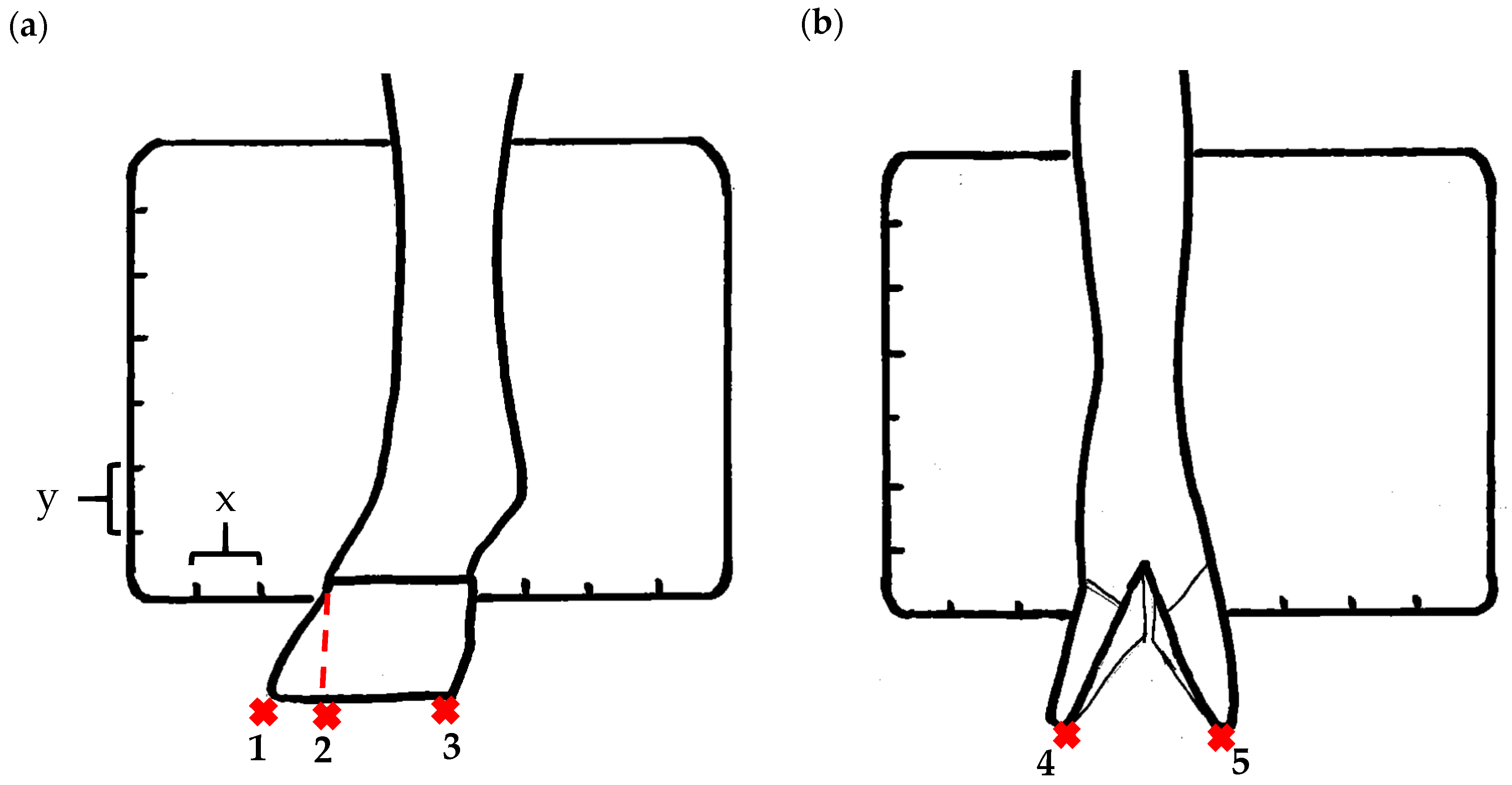

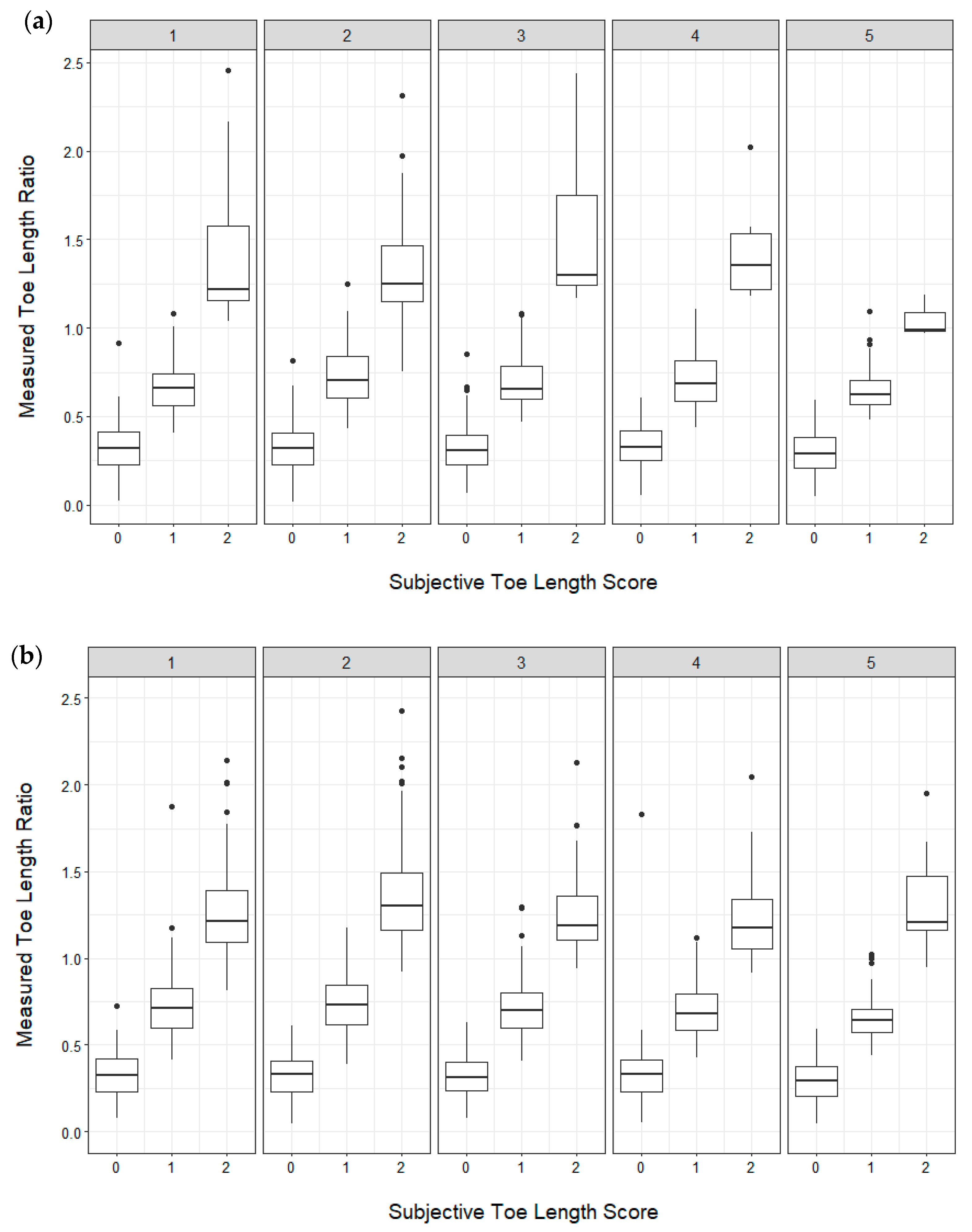
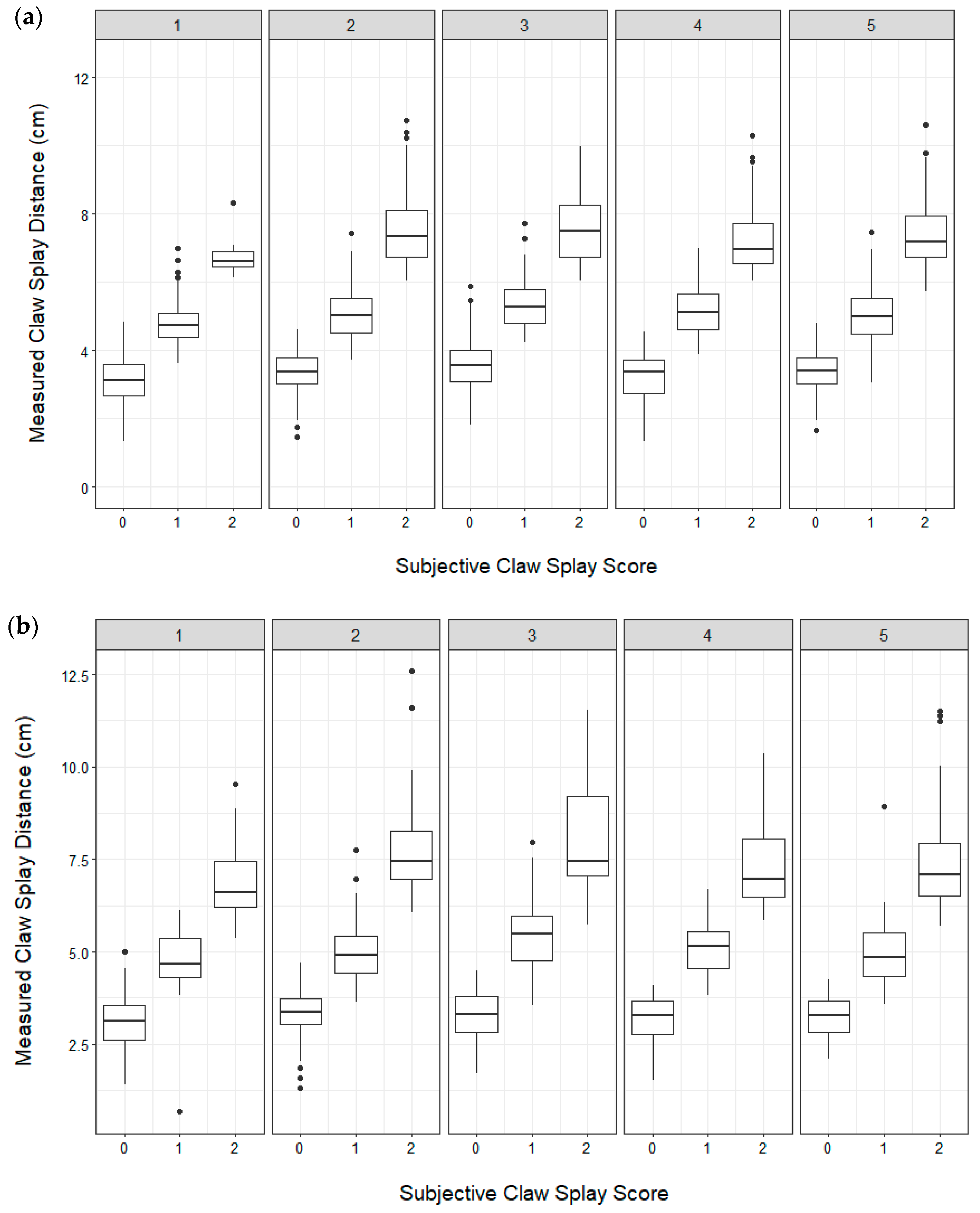
| Assessment | Stage of Production | Age | Number of Farms * | Number of Goats Contributing Photos † | Number of Lateral Aspect Photographs ** | Number of Dorsal Aspect Photographs ** | ||
|---|---|---|---|---|---|---|---|---|
| Front | Hind | Front | Hind | |||||
| 1 | First mating | 8.0 ± 0.70 | 16 | 1035 | 1018 | 1011 | 998 | 990 |
| 2 | Start of first lactation | 14.8 ± 0.86 | 15 | 791 | 782 | 769 | 760 | 769 |
| 3 | End of first lactation | 21.9 ± 0.70 | 13 | 573 | 561 | 547 | 530 | 536 |
| 4 | Start of second lactation | 29.1 ± 1.00 | 13 | 576 | 566 | 564 | 540 | 547 |
| 5 | End of second lactation | 34.1 ± 0.90 | 13 | 629 | 624 | 616 | 594 | 599 |
| Species | Assessment Type | Aspects of Hoof Conformation | References |
|---|---|---|---|
| Cows | Objective | Toe length, heel height | [15,18,31] |
| Sheep | Subjective | Shape of hoof | [6] |
| Sows | Subjective | Abnormal hoof growth, splayed feet, dipped pastern/fetlock | [11] |
| Goats | Subjective | Hoof overgrowth | [24,25,26] |
| Hoof Aspect | Ordinal Score | ||
|---|---|---|---|
| 0 | 1 | 2 | |
| Toe length | 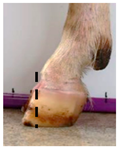 | 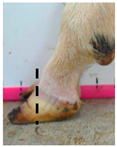 | 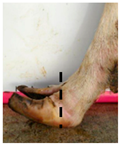 |
| Toe is not overgrown Length of the toe is less than half of the length of rest of the hoof | Toe is moderately overgrown Length of the toe is greater than half, but less than the full length of the rest of the hoof | Toe is severely overgrown Length of the toe is greater than the full length of the rest of the hoof | |
| Heel shape |  | 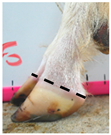 |  |
| Heel is upright Not walking on heel, coronet band parallel to ground | Heel is moderately dipped Not walking on heel, but coronet band is angled towards the ground | Heel is severely dipped Walking on heel, coronet band angled sharply towards the ground | |
| Fetlock shape * |  | 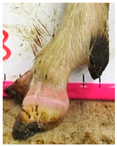 | |
| Fetlock is upright and straight | Fetlock is dipped towards the ground Bony lump on pastern may be apparent | ||
| Hoof Aspect | Ordinal Score | ||
|---|---|---|---|
| 0 | 1 | 2 | |
| Claw shape | 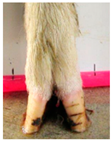 | 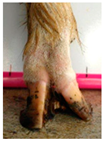 | 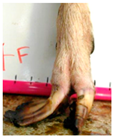 |
| Both claws are straight | One claw is bent/twisted either away or towards the midline of the hoof | Both claws are bent/twisted either away or towards the midline of the hoof | |
| Claw splay * | 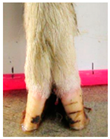 | 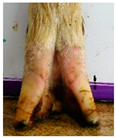 | 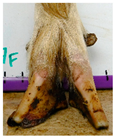 |
| Claws are not splayed the distance between the axial edge of the distal tip of both claws are approximately <2 horizontal marks on the whiteboard | Claws are moderately splayed the distance between the axial edge of the distal tip of both claws are approximately >2 and <3 marks on the whiteboard | Claws are severely splayed the distance between the axial edge of the distal tip of both claws are >3 marks on the whiteboard | |
| Test | Subjective Scores (Weighted Kappa (95% CI)) | Objective Measures (Lin′s Concordance Coefficient (95% CI)) | |||||
|---|---|---|---|---|---|---|---|
| Toe Length | Heel | Fetlock | Claw Shape | Claw Splay | Toe Length Ratio | Claw Splay Distance | |
| 1 | 0.84 (0.72–1.00) | 1.00 (1.00–1.00) | 0.83 (0.73–1.00) | 1.00 (1.00–1.00) | 1.00 (1.00–1.00) | 0.86 (0.70–0.97) | 0.97 (0.87–0.99) |
| 2 | 0.91 (0.73–1.00) | 0.92 (0.77–1.00) | 0.83 (0.73–1.00) | 1.00 (1.00–1.00) | 0.90 (0.71–1.00) | 0.79 (0.46–0.93) * | 0.97 (0.81–1.00) |
| 3 | 0.83 (0.70–1.00) | 0.85 (0.78–1.00) | 0.87 (0.61–1.00) | 0.92 (0.76–1.00) | 1.00 (1.00–1.00) | 0.80 (0.62–0.93) | 0.99 (0.94–1.00) |
| 4 | 0.83 (0.69–1.00) | 0.83 (0.71–1.00) | 1.00 (1.00–1.00) | 0.82 (0.72–1.00) | 1.00 (1.00–1.00) | 0.94 (0.82–0.98) | 0.89 (0.79–0.99) |
| 5 | 0.91 (0.75–1.00) | 1.00 (1.00–1.00) | 1.00 (1.00–1.00) | 0.87 (0.71–1.00) | 0.63 (0.39–1.00) * | 0.83 (0.67–0.91) | 0.88 (0.63–0.96) |
| 6 | 1.00 (1.00–1.00) | 0.89 (0.68–1.00) | 1.00 (1.00–1.00) | 0.88 (0.64–1.00) | 0.82 (0.60–1.00) | 0.84 (0.64–0.94) | 0.99 (0.95–1.00) |
| 7 | 1.00 (1.00–1.00) | 1.00 (1.00–1.00) | 1.00 (1.00–1.00) | 0.85 (0.68–1.00) | 0.84 (0.72–1.00) | 0.95 (0.82–0.98) | 0.99 (0.86–0.99) |
| 8 | 1.00 (1.00–1.00) | 0.88 (0.77–1.00) | 1.00 (1.00–1.00) | 0.71 (0.49–1.00) * | 0.86 (0.73–1.00) | 0.80 (0.53–0.92) | 0.97 (0.90–0.98) |
| 9 | 0.88 (0.65–1.00) | 0.89 (0.74–1.00) | 1.00 (1.00–1.00) | 0.88 (0.65–1.00) | 1.00 (1.00–1.00) | 0.97 (0.92–0.99) | 0.97 (0.81–0.99) |
| 10 | 0.87 (0.72–1.00) | 0.95 (0.88–1.00) | 1.00 (1.00–1.00) | 0.87 (0.71–1.00) | 0.83 (0.59–1.00) | 0.76 (0.64–0.84) * | 0.93 (0.83–0.97) |
| 11 | 0.88 (0.74–1.00) | 1.00 (1.00–1.00) | 1.00 (1.00–1.00) | 0.84 (0.74–1.00) | 1.00 (1.00–1.00) | 0.81 (0.69–0.92) | 0.91 (0.78–0.97) |
| 12 | 0.89 (0.78–1.00) | 1.00 (1.00–1.00) | 1.00 (1.00–1.00) | 0.86 (0.81–1.00) | 1.00 (1.00–1.00) | 0.84 (0.66–0.95) | 0.95 (0.73–0.99) |
| 13 | 0.89 (0.78–1.00) | 0.88 (0.75–1.00) | 1.00 (1.00–1.00) | 1.00 (1.00–1.00) | 1.00 (1.00–1.00) | 0.89 (0.72–0.96) | 0.96 (0.84–1.00) |
| 14 | 0.87 (0.72–1.00) | 0.96 (0.88–1.00) | 1.00 (1.00–1.00) | 0.86 (0.71–1.00) | 0.83 (0.79–1.00) | 0.86 (0.67–0.94) | 0.93 (0.79–0.98) |
| 15 | 0.92 (0.77–1.00) | 0.93 (0.80–1.00) | 1.00 (1.00–1.00) | 0.92 (0.75–1.00) | 0.81 (0.74–1.00) | 0.94 (0.88–0.97) | 0.97 (0.88–1.00) |
| Assigned Scores | Front Hooves | Hind Hooves | ||||||
|---|---|---|---|---|---|---|---|---|
| Actual Toe Length Scores a | Accuracy | Actual Toe Length Scores a | Accuracy | |||||
| 0 | 1 | 2 | 0 | 1 | 2 | |||
| 0 | 2359 | 148 | 0 | 0.93 | 1586 | 80 | 1 | 0.96 |
| (98.6%) | (15.1%) | (0.0%) | (96.0%) | (5.9%) | (0.2%) | |||
| 1 | 34 | 808 | 33 | 0.91 | 63 | 1247 | 53 | 0.93 |
| (1.4%) | (82.3%) | (22.9%) | (4.0%) | (92.2%) | (11.8%) | |||
| 2 | 0 | 5 | 111 | 0.88 | 0 | 25 | 395 | 0.94 |
| (0.0%) | (0.6%) | (77.1%) | (0.0%) | (1.8%) | (88.0%) | |||
| Total scores | 2393 | 981 | 144 | 1649 | 1352 | 449 | ||
| Assigned Scores | Front Hooves | Hind Hooves | ||||||
|---|---|---|---|---|---|---|---|---|
| Actual Claw Splay Scores a | Accuracy | Actual Claw Splay Scores a | Accuracy | |||||
| 0 | 1 | 2 | 0 | 1 | 2 | |||
| 0 | 809 | 116 | 0 | 0.95 | 548 | 60 | 0 | 0.95 |
| (97.8%) | (12.7%) | (0.0%) | (96.3%) | (11.0%) | (0.0%) | |||
| 1 | 18 | 795 | 68 | 0.90 | 21 | 481 | 45 | 0.90 |
| (2.2%) | (87.2%) | (17.0%) | (3.7%) | (87.9%) | (15.8%) | |||
| 2 | 0 | 1 | 332 | 0.91 | 0 | 6 | 239 | 0.92 |
| (0.0%) | (0.1%) | (83.0%) | (0.0%) | (1.1%) | (84.2%) | |||
| Total scores | 827 | 912 | 400 | 569 | 547 | 284 | ||
© 2019 by the authors. Licensee MDPI, Basel, Switzerland. This article is an open access article distributed under the terms and conditions of the Creative Commons Attribution (CC BY) license (http://creativecommons.org/licenses/by/4.0/).
Share and Cite
Deeming, L.E.; Beausoleil, N.J.; Stafford, K.J.; Webster, J.R.; Staincliffe, M.; Zobel, G. The Development of a Hoof Conformation Assessment for Use in Dairy Goats. Animals 2019, 9, 973. https://doi.org/10.3390/ani9110973
Deeming LE, Beausoleil NJ, Stafford KJ, Webster JR, Staincliffe M, Zobel G. The Development of a Hoof Conformation Assessment for Use in Dairy Goats. Animals. 2019; 9(11):973. https://doi.org/10.3390/ani9110973
Chicago/Turabian StyleDeeming, Laura E., Ngaio J. Beausoleil, Kevin J. Stafford, James R. Webster, Maryann Staincliffe, and Gosia Zobel. 2019. "The Development of a Hoof Conformation Assessment for Use in Dairy Goats" Animals 9, no. 11: 973. https://doi.org/10.3390/ani9110973
APA StyleDeeming, L. E., Beausoleil, N. J., Stafford, K. J., Webster, J. R., Staincliffe, M., & Zobel, G. (2019). The Development of a Hoof Conformation Assessment for Use in Dairy Goats. Animals, 9(11), 973. https://doi.org/10.3390/ani9110973





